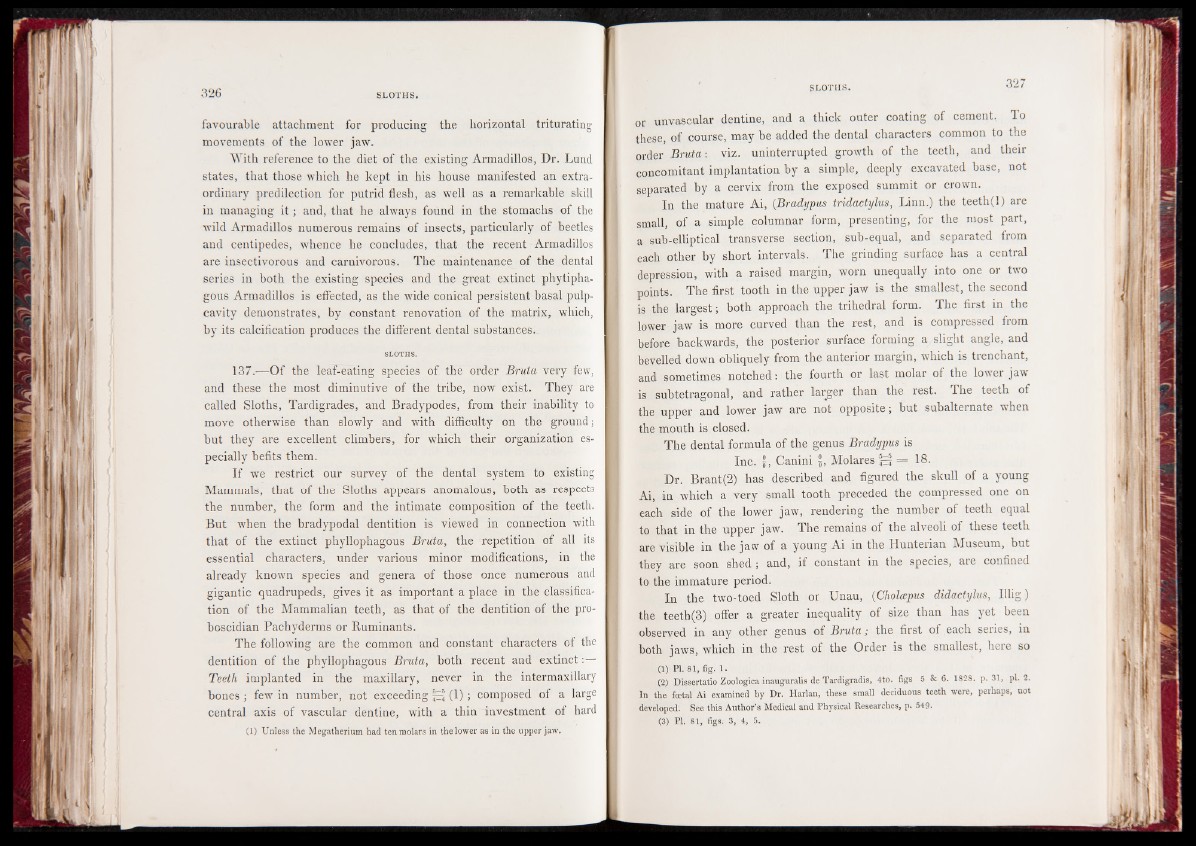
favourable attachment for producing the horizontal triturating
movements of the lower jaw.
With reference to the diet of the existing Armadillos, Dr. Lund
states, that those which he kept in his house manifested an extraordinary
predilection for putrid flesh, as well as a remarkable skill
in managing i t ; and, that he always found in the stomachs of the
wild Armadillos numerous remains of insects, particularly of beetles
and centipedes, whence he concludes, that the recent Armadillos
are insectivorous and carnivorous. The maintenance of the dental
series in both the existing species and the great extinct phytipha-
gous Armadillos is effected, as the wide conical persistent basal pulp-
cavity demonstrates, by constant renovation of the matrix, which,
by its calcification produces the different dental substances..
SLOTHS.
137.—Of the leaf-eating species of the order Bruta very few,
and these the most diminutive of the tribe, now exist. They are
called Sloths, Tardigrades, and Bradypodes, from their inability to
move otherwise than slowly and with difficulty on the ground;
but they are excellent climbers, for which their organization especially
befits them.
If we restrict our survey of the dental system to existing
Mammals, that of the Sloths appears anomalous, both as respects
the number, the form and the intimate composition of the teeth.
But when the bradypodal dentition is viewed in connection with
that of the extinct phyllophagous Bruta, the repetition of all its
essential characters, under various minor modifications, in the
already known species and genera of those once numerous and
gigantic quadrupeds, gives it as important a place in the classification
of the Mammalian teeth, as that of the dentition of the proboscidian
Pachyderms or Ruminants.
The following are the common and constant characters of the
dentition of the phyllophagous Bruta, both recent and extinct:—
Teeth implanted in the maxillary, never in the intermaxillary
bones ; few in number, not exceeding §E* (1); composed of a large
central axis of vascular dentine, with a thin investment of hard
(1) Unless the Megatherium had ten molars in the lower as in the upper jaw.
or unvascular dentine, and a thick outer coating of cement, To
these, of course, may be added the dental characters common to the
order Bruta: viz. uninterrupted growth of the teeth, and their
concomitant implantation by a simple, deeply excavated base, not
separated by a cervix from the exposed summit or crown.
In the mature Ai, (Bradypus tridactylus, Linn.) the teeth(l) are
small, of a simple columnar form, presenting, for the most part,
a sub-elliptical transverse section, sub-equal, and separated from
each other by short intervals. The grinding surface has a central
depression, with a raised margin, worn unequally into one or two
points. The first tooth in the upper jaw is the smallest, the second
is the largest; both approach the trihedral form. The first in the
lower jaw is more curved than the rest, and is compressed from
before backwards, the posterior surface forming a slight angle, and
bevelled down obliquely from the anterior margin, which is trenchant,
and sometimes notched : the fourth or last molar of the lower jaw
is sub tetragonal, and rather larger than the rest. The teeth of
the upper and lower jaw are not opposite ; but subalternate when
the mouth is closed.
The dental formula of the genus Bradypus is
Inc. 5, Canini l, Molares |E| == 18.
Dr. Brant(2) has described and figured the skull of a young
Ai, in which a very small tooth preceded the compressed one on
each side of the lower jaw, rendering the number of teeth equal
to that in the upper jaw. The remains of the alveoli of these teeth
are visible in the jaw of a young Ai in the Hunterian IMuseum, but
they are soon shed ; and, if constant in the species, are confined
to the immature period.
In the two-toed Sloth or Unau, (Choloepus didactylus, Illig )
the teeth (3) offer a greater inequality of size than has yet been
observed in any other genus of Bruta, the first of each senes, in
both jaws, which in the rest of the Order is the smallest, here so
(1) PI. 81, fig. i.
(2) Dissertatio Zoologica inauguralis de Tardigradis, 4to. figs 5 & 6. 1828. p. 31, pi. 2.
In the foetal Ai examined by Dr. Harlan, these small deciduous teeth were, perhaps, not
developed. See this Author’s Medical and Physical Researches, p. 549.
(3) PI. 81, figs. 3, 4, 5.